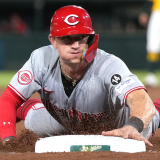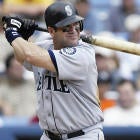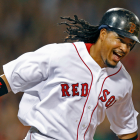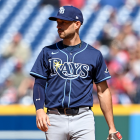
Will Edgar Martinez get in to the Hall of Fame? The case for and against him
Should it be held against Martinez that his managers didn't want him fielding?
Leading up to the announcement of the 2017 Baseball Hall of Fame class on Jan. 18, we're examining each of the 34 candidates on this year's BBWAA ballot. By way of reminder, a candidate must be named on at least 75 percent of submitted BBWAA ballots in order to be elected into the Hall of Fame.
We've already looked at the numerous candidates who are certain to fall off the ballot after only one year (candidates receiving less than five percent drop off the ballot). Now we're looking at those hopefuls who figure to have meaningful support and perhaps even earn induction at some point.
It's time now to discuss Edgar Martinez. The debate should only be how much time spent at DH one believes should disqualify a player from Hall of Fame discussions. Otherwise, Martinez flies in on merit.
A late bloomer, Martinez didn't start getting regular playing time until age 27. So some of his counting stats take a hit here, but he still packed it in.
Martinez is one of 90 players to ever top both 1200 runs (1219) and RBI (1261). He also walked more than 1200 times and if we lump that into the R/RBI thing, that gets us down to 42 players (mostly the best players ever, link here).
His 514 doubles rank 53rd in baseball history, but consider how many walks he had in addition to his late-starting career. Among players with at least 500 d0ubles -- 60 in all -- Martinez has the fewest at-bats and it's not that close. Scott Rolen had 517 doubles in 7398 at-bats, ranking second behind Martinez's 514 in 7213. Nap Lajoie had 510 in 7498. Joe Cronin, John Olerud and Joe Medwick were between 7579 and 7635 at-bats and no one else in baseball history had at least 500 doubles but fewer than 7700 at-bats.
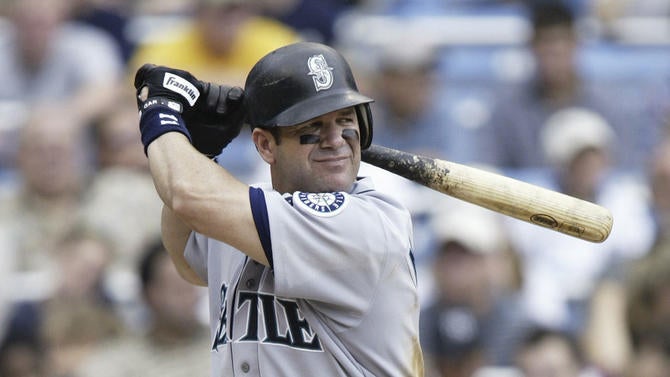
Some might find the 309 homers lacking for Edgar, but let's remember he played in homer-suppressing ballparks and is it really that big a crime to be a more well-rounded hitter instead of a home run hitter? There's room in the Hall for a guy who wasn't a home run hitter yet still managed five 25+ HR seasons.
One thing I like about Edgar that I also loved about Gary Sheffield is the walk-to-strikeout rate. Granted, Martinez wasn't as good as Sheffield on this front, but in eight of his 12 full seasons, Martinez walked more than he struck out. Through his seven-year prime, Martinez averaged 107 walks and 91 strikeouts a year. He finished with 1283 walks and 1202 strikeouts in his career, a great feat considering the time period in which he played.
When it comes to stats, I've saved the best for last. Edgar Martinez on a rate basis was as good as almost anyone who ever played the game. Among players with complete careers and more than 4000 plate appearances, he's one of 18 to slash .300/.400/.500. The others: Babe Ruth, Ted Williams, Lou Gehrig, Rogers Hornsby, Shoeless Joe Jackson, Ty Cobb, Jimmie Foxx, Stan Musial, Hank Greenberg, Tris Speaker, Frank Thomas, Mel Ott, Manny Ramirez, Harry Heilmann, Chipper Jones, Larry Walker and Todd Helton.
Martinez's .312 career batting average is 91st all time and his .515 slugging is 69th. Those are nice, but take note of the OPS: His .933 mark is 33rd in baseball history. The 147 OPS+ is 46th and that's adjusted for ballpark and era.
It still astounds me how many people view on-base percentage like some newfangled, sabermetric stat. Back when we all first started playing baseball, the most important thing when we went to bat was not making an out. That remains the case in the majors. There are only 27 precious outs in a game for your team. The goal in each plate appearance is to not make one. That's the most important thing. And that's OBP.
Edgar Martinez's .418 career OBP ranks 21st in MLB history. If we only include Hall-eligible, retired players, he's 18th. Is that good? Seriously, though, it's hard to figure being one of the best 20 ever at not making outs and still not being good enough to get into the Hall of Fame.
I know, I know. Numbers are for geeks. Why don't we listen to the players who actually faced him, they scream. Hmmm ...
"The toughest guy I faced I think -- with all due respect to all the players in the league -- was Edgar Martinez. He had to make me throw at least 13 fastballs above 95 (each time we faced). I was hard-breathing after that. Edgar was a guy that had the ability to foul off pitches, and it pissed me off because I couldn't get the guy out."
That was this guy named Pedro Martinez. Ever heard of him? How about another ...
"Edgar Martinez is, hands down, the best hitter that I've ever seen. I'm glad I didn't have to face him too much. Having seen him play from '89 to all the way when I left, I got to see him a lot against great pitchers. Like I said, hands down, he is the best pure hitter that I got to see on a nightly basis. And I hope that his time comes soon, that he gets a phone call stating that he's a Hall of Fame player, because he is."
Ho hum, that was only Randy Johnson. More?
"The toughest -- and thank God he retired -- Edgar Martinez. Oh my God. I think every pitcher will say that, because this man was tough. Great man, though -- respected the game, did what he had to do for his team. That's what you appreciate about players, when a player come and do what is right for the game of baseball, for his team and teammates."
Only the greatest closer of all-time, Mariano Rivera.
(above three quotes via seattletimes.com)
We can stop there, right?
Though Martinez never played in the World Series -- the Mariners as a franchise have never been there and he never played for anyone else -- he does have a signature postseason moment. In fact, it's one of the most memorable postseason moments in history, thanks to this being the first year with the wild card.
Before he retired, Martinez won the award for the top DH in the league five times. Now it's named after him. Yes, it's the Edgar Martinez Outstanding Designated Hitter Award. Does that matter? Maybe it should, maybe it shouldn't, but let's bear in mind we're talking about the Hall of Fame, not necessarily the "Hall of the Upper Tier Elite Players." Some might believe the award being named after him helps his Hall of Fame case.
So, again, Martinez's bat was easily Hall-worthy. Anyone who says otherwise is ignorant to the subject at hand (very possible, given that he played his entire career in the city furthest from any other big-league baseball cities), being intellectually dishonest or deluding themselves.
No, the only real opposition here digs its heels in when it comes to that damn, dirty, designated hitter thing. Granted, it's been around since 1973 and that it's used in college, high school, middle school and even Little League, but it still infuriates lots of people. It's kind of amazing how MAD ONLINE some get over it. Further, many argue that a player isn't worthy of being a Hall of Famer if "he isn't good enough to field his position."
A few counterpoints:
1. His position is DH.
2. The Hall of Fame already houses some below average to bad defensive players. Is it better to hurt one's team in the field or just only help it by hitting? They don't force quarterbacks to play defense in the NFL anymore. It's odd to me to see how many of the same people go crazy about a DH not fielding his position while ignoring the defensive difference between Mike Trout and Miguel Cabrera in 2012 MVP voting. I mean, do you care about defense or not? Just standing there with a glove isn't playing defense.
3. There are closers in the Hall of Fame. If a pitcher only has to throw an inning or two at the end of the game, is that really having more of an impact on the season than a guy who hits in the lineup every single game?
For example, Bruce Sutter appeared in 661 games in his Hall of Fame career, working 1042 innings and facing 4251 batters. Edgar Martinez appeared in 2055 games and stepped to the plate 8647 times. Martinez had more than double the plate appearances than Sutter did batters faced. Isn't that pretty much as apples to apples as we can get when it comes to pitcher vs. hitter comparisons on playing time? Through this very salient lens, Martinez impacted more baseball than Sutter, Goose Gossage, Rollie Fingers, Trevor Hoffman and Mariano Rivera (even if we include the postseason, Rivera only faced 5630 batters in his career).
If Martinez is a part-timer, these closers are far less than that.
4. Frank Thomas is in the Hall while David Ortiz will likely join him.
We could mention Molitor or Jim Thome (who joins the ballot next year and surely gets in), but neither had more than half his plate appearances as a DH. But if Thomas and Ortiz are Hall of Famers, who can use "but he didn't field his position" to eliminate Martinez from Hall discussion?
Let's see what the big difference is here in plate appearances.
| Player | Career PA | PA as DH | Percent |
| Thomas | 10,075 | 5698 | 56.6 |
| Ortiz | 10,091 | 8861 | 87.9 |
| Martinez | 8674 | 6218 | 71.7 |
Nevertheless, we'll continue to see opposition to Martinez as a Hall of Famer. Some might think he needed to hit more home runs to compensate for not fielding -- thereby justifying Thomas and/or Ortiz. Others might come with some lesser arguments in order to justify not wanting him in. Still others will build up some mighty tall Strawmen like "he wasn't too feared." (He was, by the way, but whatever). It happens.
Perhaps some good news for Edgar fans everywhere, namely Seattle? He's gained a lot of votes so far this year. In fact, per Ryan Thibodaux's ballot tracker, Edgar is already plus-29 from last year. So expect the 43.4 percent figure he got last year to rise, possibly up over 50 percent.
Of course, this is Martinez's eighth year on the ballot. He won't make it this time, so he'll need to get the expected huge leap this year, another next year and hope for the final year vote to get him in. It's not a lost cause, but it's far from a sure thing.
Other Hall of Fame cases: Posada | Ramirez | Guerrero | Rodriguez | Sosa | Wagner | Walker | Kent | McGriff | Smith | Mussina






